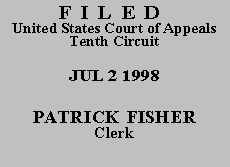

| UNITED STATES OF AMERICA,
vs.
EARL GENE RAMSEY |
|
Mr. Ramsey's sole issue on appeal is the sufficiency of the evidence. He contends that the evidence is insufficient to establish constructive possession of the firearm because the officers testifying at trial presented mutually exclusive accounts of Mr. Ramsey's relationship to the firearm that was discovered.
To prove a violation of § 922(g)(1), the government was required to show Mr. Ramsey's knowing possession of a firearm. See United States v. Capps, 77 F.3d 350, 352 (10th Cir.), cert. denied, 518 U.S. 1027 (1996). Although the government may rely upon actual or constructive possession, see United States v. Taylor, 113 F.3d 1136, 1144-45 (10th Cir. 1997), the evidence in this case when viewed in the light most favorable to the government was sufficient for a rational trier of fact to find actual possession beyond a reasonable doubt--that Mr. Ramsey had physical control over a firearm, and dropped it on the ground prior to being apprehended. Merely because one of the officers from a different vantage point did not observe Mr. Ramsey concealing or dropping a firearm did not preclude the jury from believing the other officer who so testified.
Contrary to Mr. Ramsey's position, the issue is whether a reasonable jury could have found possession beyond a reasonable doubt, not whether the evidence in this case is consistent with both innocence and guilt. See United States v. Hooks, 780 F.2d 1526, 1530-31 (10th Cir.), cert. denied, 475 U.S. 1128 (1986). Moreover, conflicts in the officers' testimony about other matters, i.e., who handcuffed Mr. Ramsey and whether a magazine was inserted in the firearm, were for the jury to consider in deciding credibility and such conflicts are presumed to have been resolved in favor of the prosecution. See Jackson v. Virginia, 443 U.S. 307, 326 (1979).
AFFIRMED.
Entered for the Court
Paul J. Kelly, Jr.
Circuit Judge
*. This order and judgment is not binding precedent, except under the doctrines of law of the case, res judicata, and collateral estoppel. This court generally disfavors the citation of orders and judgments; nevertheless, an order and judgment may be cited under the terms and conditions of 10th Cir. R. 36.3.
**. After examining the briefs and the appellate record, this three-judge panel has determined unanimously that oral argument would not be of material assistance in the determination of this appeal. See Fed. R. App. P. 34(a); 10th Cir. R. 34.1.9. The cause is therefore ordered submitted without oral argument.